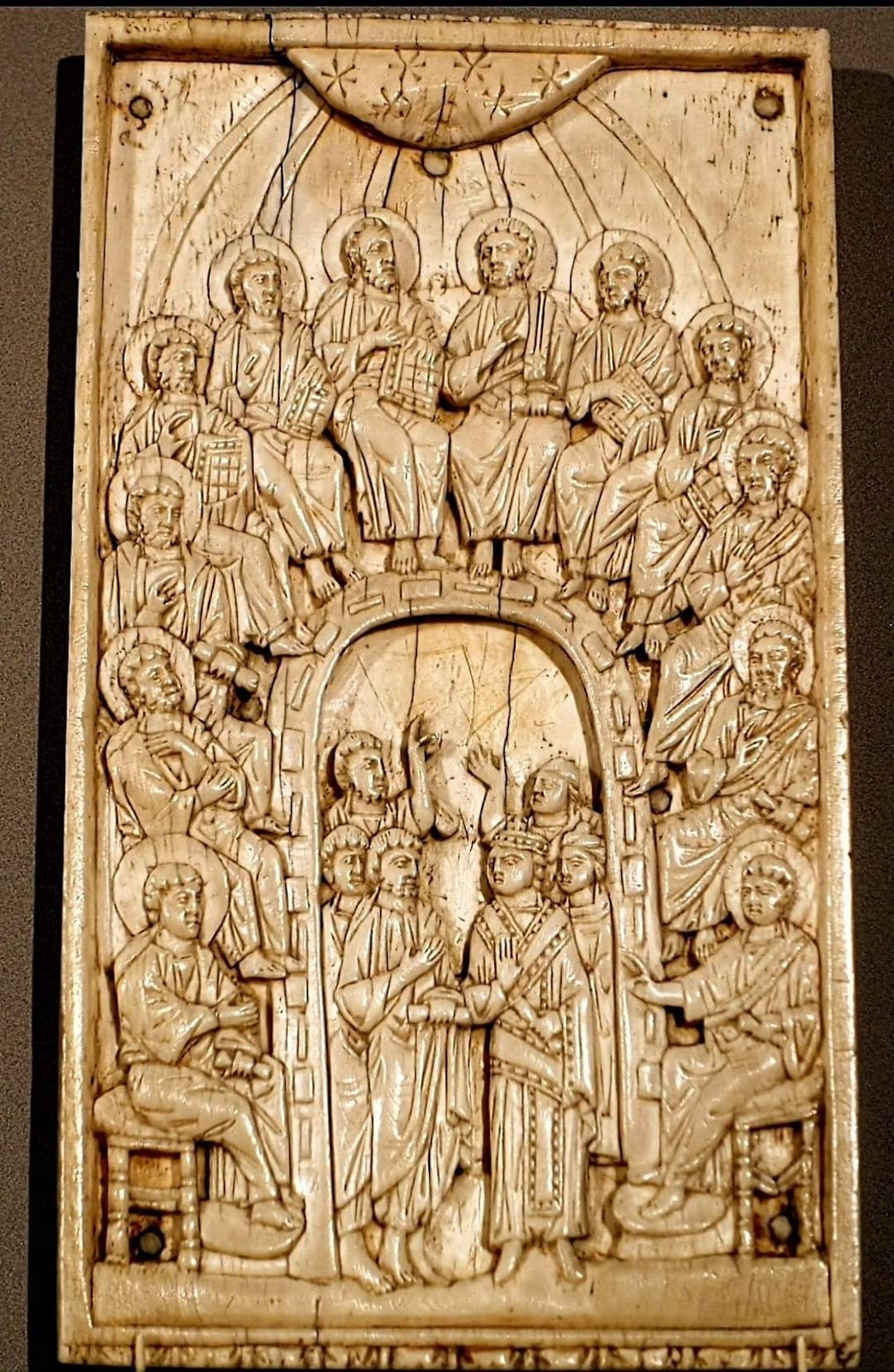Εὐλογητός εἶ. Χριστέ ὁ Θεός ἡμῶν, ὁ πανσόφους τοὺς ἁλιεῖς ἀναδείξας, καταπέμψας αὐτοῖς τὸ Πνεῦμα τὸ Ἅγιον, καί δι' αὐτῶν τήν οἰκουμένην σαγηνεύσας, Φιλάνθρωπε δόξα Σοι.
Σάν ἑορτὴ τοῦ τέλους, που σηματοδοτεῖται ἀπό τήν ἐκπλήρωση τῆς ὑπόσχεσης τοῦ Ἰησοῦ να στείλει τό Ἅγιο Πνεῦμα, ἡ Πεντηκοστή ἐγκαινιάζει μια νέα περίοδο: την γέννηση τῆς Ἐκκλησίας, τοῦ Θεανθρωπίνου Σώματος τοῦ Χριστοῦ. Μέλη αὐτοῦ τοῦ Σώματος εἶναι οἱ πιστοί, πού συγκεντρώνονται για να μετάσχουν στην Εὐχαριστία.
Το Πνεῦμα τὸ Ἅγιο, Πνεῦμα τῆς ἀληθείας καί χορηγός τῆς ζωῆς, ποὺ ἐστάλη στούς συγκεντρωμένους Ἀποστόλους στούς ὁποίους προστίθεται καί ὁ Ἀπόστολος Παῦλος ἁγιάζει, φωτίζει καί μεταδίδει τήν δύναμη τῆς Ἀνάστασης τοῦ Κυρίου Ἰησοῦ.
Οἱ πύρινες γλώσσες διανέμονται στον καθένα ἀπό τούς ἀποστόλους. Για να τους καθοδηγήσουν. Ἀλλά καί γιά νά τούς ἑνώσουν στο κήρυγμα τοῦ Εὐαγγελίου πρός τον κόσμο.
Ἕνας ἐλεύθερος χώρος, προορισμένος για τον Χριστό, τήν κεφαλή τῆς Ἐκκλησίας, χωρίζει τούς Ἀποστόλους Πέτρο καί Παύλο, πού καταλαμβάνουν τὸ ἐπάνω μέρος τῆς εἰκόνας. Με τα βλέμματά τους στραμμένα σε διαφορετικές κατευθύνσεις, οἱ Ἀπόστολοι δηλώνουν την διαφορά τῶν χαρισμάτων τους.
Ὁ ἐστεμμένος γέροντας, που φαίνεται ὄρθιος σε μια σκοτεινή κοιλότητα, ἀποτελεῖ προσωποποίηση τοῦ κόσμου, πού ἦταν θύμα τῆς εἰδωλολατρίας (δηλαδή τῆς πλάνης). Καί ἀκριβῶς γι' αὐτό ἔρχεται το Ἅγιο Πνεῦμα. Γιά νά τόν ἀπελευθερώσει με την φανέρωση τοῦ Θεανθρώπου. Οἱ δώδεκα κύλινδροι τῆς περγαμηνῆς, ἀπλωμένοι μέσα σ' ἕνα πέπλο, συμβολίζουν το μήνυμα τοῦ Εὐαγγελίου, πού θά ἀναγγέλλεται στο ἑξῆς στα ἔθνη ἀπό τούς Ἀποστόλους.
Blessed are You, O Christ our God. You sent down the Holy Spirit into the fishermen, and You gave them knowledge and wisdom in everything; and through them, as in a net You caught the whole world. O Lord who loves humanity, glory to You!
As a feast of the end, marked by the fulfillment of Jesus' promise to send the Holy Spirit, Pentecost inaugurates a new era: the birth of the Church, the God-man Body of Christ. Members of this Body are the faithful who gather to partake in the Eucharist.
The Holy Spirit, the Spirit of truth and Giver of life, who was sent to the gathered Apostles, including the Apostle Paul, sanctifies, enlightens, and imparts the power of the Resurrection of the Lord Jesus.
The tongues of fire are distributed to each of the Apostles. To guide them. But also to unite them in preaching the Gospel to the world.
A free space, destined for Christ, the head of the Church, separates the Apostles Peter and Paul, who occupy the upper part of the icon. With their gazes directed in different directions, the Apostles declare the diversity of their gifts.
The crowned elder, standing upright in a dark cavity, personifies the world, which was a victim of idolatry (that is, deception). And it is precisely for this reason that the Holy Spirit comes. To liberate it by revealing the God-man. The twelve scrolls of parchment, spread within a veil, symbolize the message of the Gospel, which will henceforth be proclaimed to the nations by the Apostles.
Πεντηκοστή, Μεγαλο Μετεωρο, 15ος αι.
Πεντηκοστή, Μονή Αγ. Παύλου,Αθως, 15ος αι
Πεντηκοστή,Βυζαντινό μουσείο Αθηνών, 15ος αι,
Πεντηκοστή, μουσείο Bode,Βερολίνο, 11ος αι.
Πεντηκοστή, μουσείο Ερμιτάζ, 10ος αι.
Πεντηκοστή, Ι. Ναος Αγ. Ιεροθέου κ Στεφάνου, Βουδαπέστη, 2014, εικόνα του ΕΡΓΑΣΤΗΡΙΟΥ μας.









